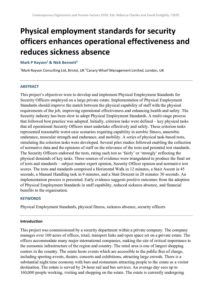| Document | Author Mark P Rayson & Nick Bennett |
| Abstract This project’s objectives were to develop and implement Physical Employment Standards for Security Officers employed on a large private estate. Implementation of Physical Employment Standards should improve the match between the physical capability of staff with the physical requirements of the job, improving operational effectiveness and enhancing health and safety. The Security industry has been slow to adopt Physical Employment Standards. A multi-stage process that followed best practice was adopted. Initially, criterion tasks were defined – key physical tasks that all operational Security Officers must undertake effectively and safely. These criterion tasks represented reasonable worst-case scenarios requiring capability in aerobic fitness, anaerobic endurance, muscular strength and endurance, and mobility. A series of physical task-based tests, simulating the criterion tasks were developed. Several pilot studies followed enabling the collection of normative data and the opinions of staff on the relevance of the tests and potential test standards. The Security Officers endorsed the tests, rating each test as ‘fairly’ or ‘strongly’ reflecting the physical demands of key tasks. Three sources of evidence were triangulated to produce the final set of tests and standards – subject matter expert opinion, Security Officer opinion and normative test scores. The tests and standards comprised a Horizontal Walk in 12 minutes, a Stair Ascent in 45 seconds, a Manual Handling task in 9 minutes, and a Stair Descent in 20 minutes 30 seconds. An implementation process is presented. Early evidence suggests positive outcomes from the adoption of Physical Employment Standards in staff capability, reduced sickness absence, and financial benefits to the organisation. |

